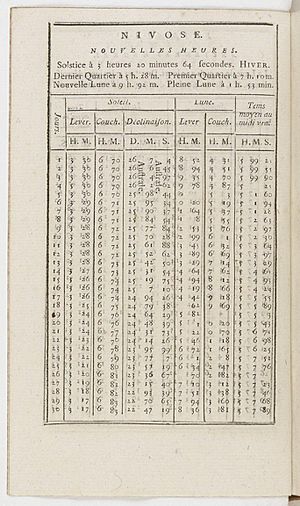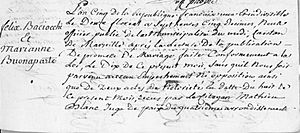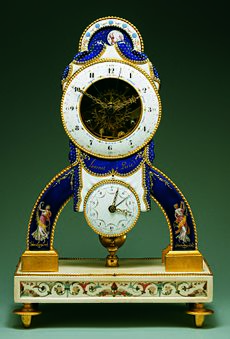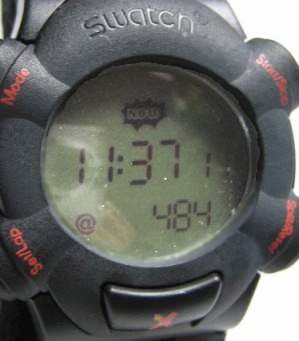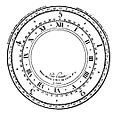Decimal time facts for kids
Decimal time is a way of telling time using units that are based on the number 10. Instead of dividing the day into 24 hours, 60 minutes, and 60 seconds, a decimal time system divides the day into 10 main parts. Each of these parts can then be divided into 100 smaller parts, and so on.
The most famous example of decimal time was used in France during the French Revolution. They divided the day into 10 "decimal hours." Each decimal hour had 100 "decimal minutes," and each decimal minute had 100 "decimal seconds." This means there were 100,000 decimal seconds in a day, compared to 86,400 regular seconds.
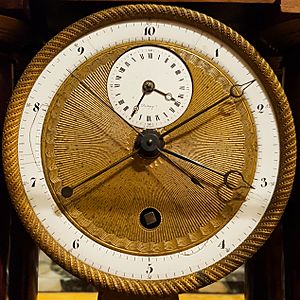
The main idea behind decimal time is to make calculations easier. Since our number system is based on 10 (decimal), it's simpler to work with time units that also use 10. For example, if you have 1 decimal hour, 23 decimal minutes, and 45 decimal seconds, you can just write it as 1.2345 decimal hours. This makes it easy to see what fraction of the day has passed. For instance, 0.54321 of a decimal day means 5 decimal hours, 43 decimal minutes, and 21 decimal seconds into the day.
Here's how decimal time compares to regular time:
| Decimal time | Regular 24-hour time | Regular 12-hour time |
|---|---|---|
| 0 (Midnight) | 00:00 | 12:00 a.m. |
| 1 | 02:24 | 2:24 a.m. |
| 2 | 04:48 | 4:48 a.m. |
| 3 | 07:12 | 7:12 a.m. |
| 4 | 09:36 | 9:36 a.m. |
| 5 (Noon) | 12:00 | 12:00 p.m. |
| 6 | 14:24 | 2:24 p.m. |
| 7 | 16:48 | 4:48 p.m. |
| 8 | 19:12 | 7:12 p.m. |
| 9 | 21:36 | 9:36 p.m. |
Contents
History of Decimal Time
Ancient Egypt
Ancient Egyptians used a system related to decimal time with "decans." These were 36 groups of stars. Every 10 days, a new decan star group would appear in the sky at dawn. This helped them divide the year into 36 periods of 10 days each. They added five extra days to make a 365-day year.
China
China used decimal time for much of its history, alongside their usual 12-hour system. The day was divided into 10 "shi" or 100 "ke." Later, in 1280, the "Shoushi" calendar divided each "ke" into 100 "fen," and each "fen" into 100 "miao." This created a full decimal time system.
However, in 1645, China switched to a calendar based on European astronomy. This new system used 96 "ke" per day, making each "ke" exactly one-quarter of an hour.
Chinese people also used "gēng" as a time signal, often sounded by drums or gongs. There were 10 "gēng" in a day, with each "gēng" lasting 2.4 hours (2 hours and 24 minutes). Days were also grouped into 10-day weeks called "xún."
France
Before the Revolution
Even before the French Revolution, some thinkers suggested using a decimal system for everything, including time. In 1754, Jean le Rond d'Alembert wrote that it would be much easier if all measurements, like money, length, and time, were divided by tens.
In 1788, Claude Boniface Collignon proposed dividing the day into 10 hours. Each new hour would have 100 minutes, each minute 1,000 seconds, and so on.
During the French Republic
Decimal time became official during the French Revolution. On October 5, 1793, a law was passed to introduce it. The law stated that the day, from midnight to midnight, would be divided into 10 hours. Each hour would be divided into 100 "decimal minutes," and each minute into 100 "decimal seconds." This system was supposed to start on September 22, 1794.
So, midnight was "ten hours," and noon was "five hours." Sometimes, decimal hours were divided into tenths, called "décimes." One "décime" was equal to 10 decimal minutes.
How it was used
Even though clocks were made to show both regular and decimal time, decimal time never really became popular. Its mandatory use was stopped on April 7, 1795. However, some cities like Marseille and Toulouse continued to use it for a few years. In some places, it was even used to record births, marriages, and deaths until 1800.
Decimal time was part of a bigger plan in revolutionary France to make everything decimal, including money and measurements (the metric system). The French Republican Calendar also divided months into three 10-day periods.
Metric System and Time
When the metric system was created, the goal was to replace all old units with new, decimal ones. This included length, weight, and time. While the metric system for length and weight became widely used, the decimal system for time didn't catch on.
In 1794, Joseph-Louis Lagrange suggested dividing the day into 10 "decidays" and 100 "centidays." A "centiday" would be 1/10,000 of a day, or about 8.64 seconds.
However, many people, including C.A. Prieur, argued against making decimal time mandatory. They pointed out that it offered no real advantage for most people, would be hard to get used to, and would be expensive to change all the clocks. They suggested keeping it for special uses like astronomy or science, where it could be helpful.
As predicted, astronomers found decimal time useful, and they still use it today in the form of "fractional days."
Later Ideas
Even after the French Revolution, there were other attempts to bring back decimal time. In the 1890s, Joseph Charles François de Rey-Pailhade suggested dividing the day into 100 parts called "cés." Each "cé" would be about 14.4 regular minutes.
In 1897, a French commission, including the famous mathematician Henri Poincaré, tried a different approach. They suggested keeping the 24-hour day but dividing each hour into 100 decimal minutes, and each minute into 100 seconds. This plan also didn't become popular and was dropped in 1900.
Switzerland
In 1998, the Swiss watch company Swatch introduced a decimal time system called Swatch Internet Time. It divided the day into 1,000 ".beats." Each .beat was 86.4 seconds long. @000 .beats was midnight, and @500 .beats was noon in Switzerland.
While Swatch didn't officially define smaller units, some people used "centibeats" (one-hundredth of a .beat). One centibeat was equal to one French decimal second (0.864 seconds). So, 9 PM in regular time would be @875.00 in extended Swatch Internet Time. Swatch no longer sells digital watches that use Internet Time.
Conversions
In the French decimal time system, there were 100,000 decimal seconds in a day. This means a decimal second was shorter than a standard second. A standard second is 0.864 decimal seconds.
Here's a quick look at how decimal units compare to standard time:
| Unit | Seconds (SI) | Minutes | Hours | h:mm:ss.sss |
|---|---|---|---|---|
| 1 Decimal second | 0.864 | 0.0144 | 0.00024 | 0:00:00.864 |
| 1 Decimal minute | 86.4 | 1.44 | 0.024 | 0:01:26.400 |
| 1 Décime | 864 | 14.4 | 0.24 | 0:14:24.000 |
| 1 Decimal hour | 8,640 | 144 | 2.4 | 2:24:00.000 |
Decimal Hours
Another type of decimal time is simply using decimal fractions of an hour. For example, instead of saying 30 minutes, you might say 0.5 hours. This is common in some jobs, like accounting or aviation.
- Payroll: When tracking work hours, 8:30 AM might be recorded as 8.50 hours. This makes it easier to calculate pay without converting minutes.
- Aviation: Pilots often use decimal hours to add up flight times. Adding 1.6 hours to 2.6 hours (which is 1 hour 36 minutes + 2 hours 36 minutes) is simpler than dealing with minutes that go over 60.
Fractional Days
Scientists and computers often represent the time of day as a decimal fraction of a whole day. To do this, you divide the number of hours past midnight by 24. So, midnight is 0.0 day, and noon is 0.5 day.
This method simplifies time calculations because you only deal with one unit (days) instead of four (days, hours, minutes, seconds). For example, astronomers use fractional days to record observations.
Decimal Multiples of the Second
The "second" is the basic unit of time in the International System of Units (SI). While we usually use minutes, hours, and days for longer periods, it's possible to use decimal multiples of the second. For example:
- Kilosecond (ks): 1,000 seconds.
- Megasecond (Ms): 1,000,000 seconds.
You could say 3:45 PM is 56.7 kiloseconds past midnight (since there are 86.4 kiloseconds in a day). However, this is rarely used in everyday life.
Scientific Decimal Time
Scientists often use decimal numbers for time to make plotting data easier. For example, they might use decimal days or decimal years.
- Seconds in a decimal minute: If you divide a standard minute (60 seconds) into 10 parts, each part is 6 seconds.
| Decimal minutes | 0.1 | 0.2 | 0.3 | 0.4 | 0.5 | 0.6 | 0.7 | 0.8 | 0.9 | 1.0 |
|---|---|---|---|---|---|---|---|---|---|---|
| Seconds | 6s | 12s | 18s | 24s | 30s | 36s | 42s | 48s | 54s | 60s |
- Minutes in a decimal hour: If you divide a standard hour (60 minutes) into 10 parts, each part is 6 minutes.
| Decimal hours | 0.1 | 0.2 | 0.3 | 0.4 | 0.5 | 0.6 | 0.7 | 0.8 | 0.9 | 1.0 |
|---|---|---|---|---|---|---|---|---|---|---|
| Minutes | 6m | 12m | 18m | 24m | 30m | 36m | 42m | 48m | 54m | 60m |
- Hours in a decimal day: If you divide a standard day (24 hours) into 10 parts, each part is 2.4 hours (2 hours and 24 minutes).
| Decimal days | 0.1 | 0.2 | 0.3 | 0.4 | 0.5 | 0.6 | 0.7 | 0.8 | 0.9 | 1.0 |
|---|---|---|---|---|---|---|---|---|---|---|
| Hours/minutes | 2h 24m | 4h 48m | 7h 12m | 9h 36m | 12h | 14h 24m | 16h 48m | 19h 12m | 21h 36m | 24h |
- Length of a decimal year: A "Julian year" is exactly 365.25 days long. So, a tenth of a year is 36.525 days (36 days, 12 hours, 36 minutes).
| Decimal years | 0.0 | 0.1 | 0.2 | 0.3 | 0.4 | 0.5 | 0.6 | 0.7 | 0.8 | 0.9 | 1.0 |
|---|---|---|---|---|---|---|---|---|---|---|---|
| Days | 0 | 36.525 | 73.050 | 109.575 | 146.100 | 182.625 | 219.150 | 255.675 | 292.200 | 328.725 | 365.250 |
| Date Time |
1 Jan 00:00 |
6 Feb 12:36 |
15 Mar 01:12 |
20 Apr 13:48 |
27 May 2:24 |
1 Jul 15:00 |
8 Aug 03:36 |
13 Sep 16:12 |
20 Oct 04:48 |
25 Nov 17:24 |
1 Jan 06:00 |
Other Decimal Times
Many people have suggested different ways to use decimal time. Most of these ideas are based on "fractional days," meaning they divide the day into decimal parts. This makes it easy to convert between different decimal time systems. For example, all these mean the same moment:
- 0.500 day
- 5 decimal hours (French system)
- @500 .beats (Swatch Internet Time)
- 50.0 "kes" or "cés" (centidays)
- 500 millidays
- 50.0% of the day
- 12:00 (noon) in standard time
Some decimal time ideas use different "metric" units for time. The main difference is that "metric time" defines units for measuring how long something lasts (like with a stopwatch), while "decimal time" defines the time of day (like with a clock).
In the fictional Star Trek universe, "stardates" are a form of decimal time. Each stardate unit represents one "milliyear" (one-thousandth of a year).
Images for kids
- 12-hour clock
- 24-hour clock
- Centesimal minute and second of arc
- Decimal calendar
- Hexadecimal time
- List of unusual units of measurement
- Metric time
- Stardate
- Unix time
See also
 In Spanish: Tiempo decimal para niños
In Spanish: Tiempo decimal para niños


